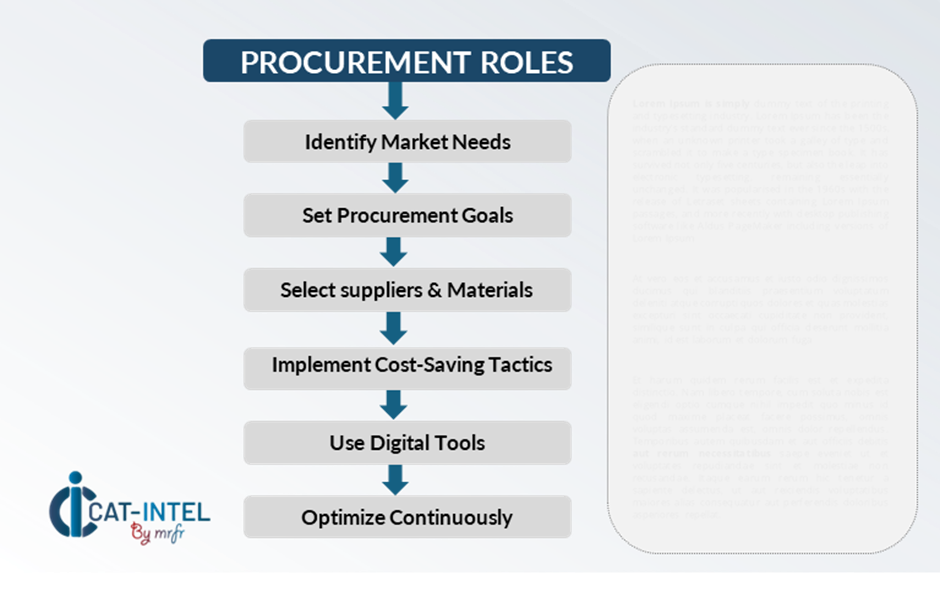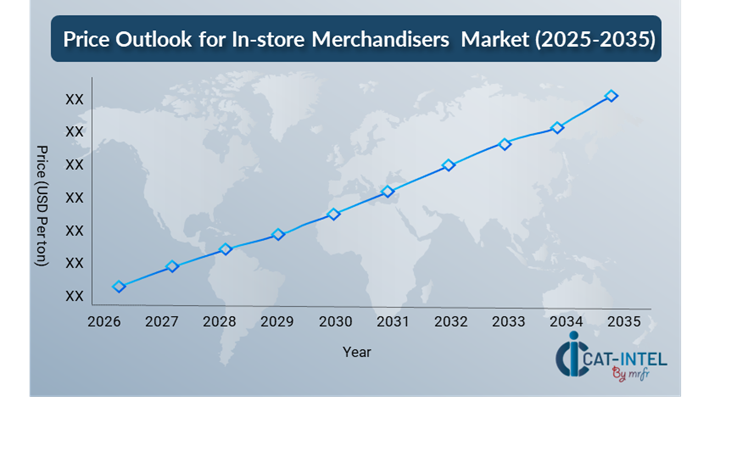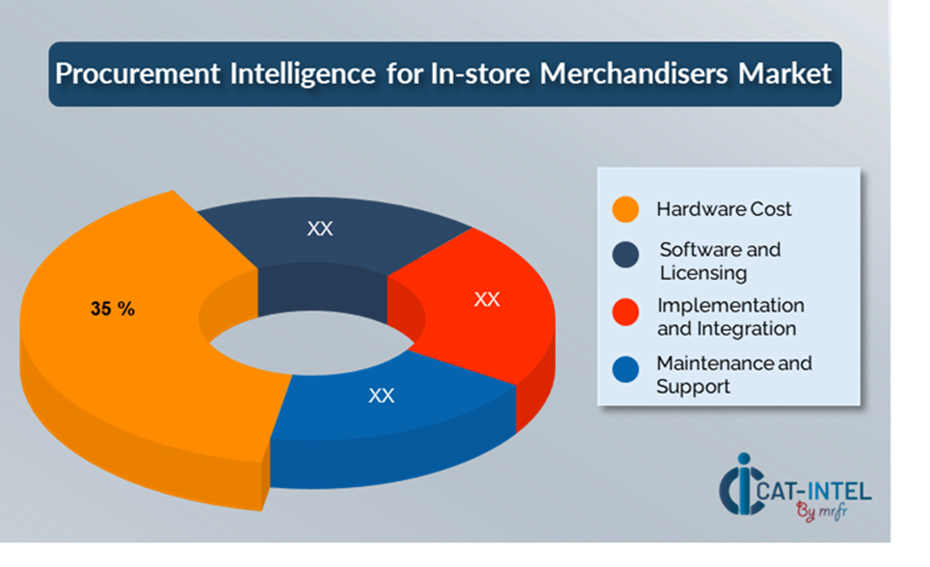Summary Overview
In-store Merchandisers Market Overview
The global in-store merchandising industry is steadily expanding, fuelled by rising demand in areas such as retail, consumer goods, and hospitality. This industry covers a wide range of merchandising solutions, from basic in-store displays to modern digital and interactive signage systems. Our analysis focuses on major procurement trends, such as cost optimization tactics and the use of novel systems to improve visibility of products and store operations.
Looking ahead, various issues will influence the future of in-store retail, including installation costs, scalability, and effective inventory management. Integrating modern merchandising technology with existing retail systems is critical for providing a consistent consumer experience and increasing shop efficiency. As demand continues to climb, retailers are harnessing market intelligence to optimize product placement tactics and increase sales and reduce operational risk. Strategic merchandising, underpinned by digital technologies and data-driven insights, will be critical to achieving long-term market success.
Market Size The global In-store Merchandisers market is projected to reach USD 0.42 billion by 2035, growing at a CAGR of approximately 7.83% from 2025 to 2035.

Growth Rate 7.83%
-
Sector Contributions Growth in the market is driven by -
Manufacturing and Retail Optimization There is a growing demand for real-time data and integrated merchandising systems to improve inventory management, product positioning, and store operations.
-
Retail and E-Commerce Growth A greater emphasis on implementing advanced in-store merchandising technologies to improve product visibility, enhance consumer experiences, and drive higher conversion rates.
-
Technological Advancements AI, machine learning, and augmented reality are improving in-store merchandising, providing predictive analytics for customer behaviour, and automating product placement decisions.
-
Innovations Modular merchandising systems enable retailers to pick and integrate only the essential display and promotional functionalities, lowering costs and complexity while increasing shop layout efficiency.
-
Investment Initiatives Retailers are investing in smart, cloud-based merchandising technologies to lower operating costs, increase scalability, and provide real-time access to sales and inventory data.
-
Regional Insights North America and Asia-Pacific are the market's largest contributors, owing to robust retail infrastructure, widespread technological adoption, and a growing emphasis on interactive in-store experiences.
Key Trends and Sustainability Outlook
-
Cloud Integration There is a growing use of cloud-based merchandising systems to expand scalability, reduce operating costs, and improve real-time access to product data and store analytics.
-
Advanced Features AI, IoT, and digital signage are integrated to improve merchandising decisions, automate product restocking, and increase consumer engagement through personalized experiences.
-
Focus on Sustainability In-store merchandising solutions align with sustainability goals by enabling effective product tracking, minimizing waste, and boosting energy efficiency
-
Customization Trends There is a growing desire for customized merchandising solutions specialized to certain industries such as fashion, electronics, and grocery, allowing for more targeted consumer involvement.
-
Data-Driven Insights Advanced analytics and customer insights enable retailers to manage shelf space, estimate demand, and measure store performance metrics, resulting in increased sales.
Growth Drivers
-
Digital Transformation Increased use of digital tools and interactive displays to improve the customer experience and expedite in-store processes, resulting in higher overall sales.
-
Demand for Automation There is a growing reliance on automated merchandising systems to expedite repetitive processes like inventory checks, product replenishment, and shelf management, decreasing human error and operating bottlenecks.
-
Scalability Needs Retailers are looking for scalable in-store merchandising systems that can grow with their store sizes and product offers to ensure efficient operations across multiple locations.
-
Regulatory Compliance Advanced merchandising tools assist merchants in meeting regulatory requirements for product labelling, price accuracy, and health and safety regulations.
-
Globalization There is a demand for merchandising systems that help multinational retailers manage different shop locations, currencies, and region-specific client preferences.
Overview of Market Intelligence Services for the In-store Merchandisers Market
Recent research has revealed critical hurdles in the in-store merchandising business, including high implementation costs and the need for customization to match individual retail requirements. Market intelligence studies provide useful insights into procurement prospects, assisting businesses in identifying cost-saving initiatives, optimizing supplier relationships, and ensuring the success of merchandising system implementations. These insights also help to assure industry compliance and high-quality shop operations while keeping expenses under control.
Procurement Intelligence for In-store Merchandisers Category Management and Strategic Sourcing
To keep their competitive edge in the in-store merchandising sector, retailers are streamlining procurement processes using supplier performance and track market trends. Effective category management and strategic sourcing are essential for lowering procurement costs and maintaining consistent supply of high-quality merchandising solutions. Businesses that use actionable market research can improve their procurement strategy, negotiate better terms with suppliers, and assure the best selection of merchandising tools for their needs. This technique assists retailers in improving store displays, providing better customer experiences, and driving total sales growth.

Pricing Outlook for In-store Merchandisers Spend Analysis
The pricing prognosis for in-store merchandising solutions is projected to remain moderately dynamic, with fluctuations caused by a variety of factors. Key factors include technological developments, need for cloud-based merchandising systems, customized requirements, and regional pricing disparities. Furthermore, the increasing adoption of AI, IoT integrations, and the growing focus on data security and compliance are exerting upward pressure on merchandising solution pricing.

Graph shows general upward trend pricing for In-store Merchandisers and growing demand. However, there may be fluctuations influenced by economic conditions, technological advancements, and competitive dynamic.
To effectively manage budgets, optimize procurement procedures, improve vendor relationships, and implement modular merchandising solutions. Leveraging digital technologies for market tracking, leveraging analytics for price forecasting, and establishing effective contract management procedures can all help to save costs when purchasing in-store merchandising systems.
Partnering with reputable providers, negotiating long-term contracts, and looking into subscription-based or pay-per-use pricing structures are all effective techniques for managing merchandising solution expenses. Despite these pricing challenges, scalability, successful implementation, and the adoption of cloud-based merchandising systems will be critical for sustaining cost-effectiveness and operational efficiency in retail environments.
Cost Breakdown for In-store Merchandisers Total Cost of Ownership (TCO) and Cost-Saving Opportunities

- Hardware Cost (35%)
-
Description Hardware costs include the fees incurred when purchasing actual in-store merchandising hardware such as digital advertising displays, kiosks, sensors, mobile devices, and RFID systems.
-
Trend There is an increasing trend of using cloud-based hardware systems and leasing options to minimize upfront capital expenses, which can help merchants save money on early investments.
- Software and Licensing (XX%)
- Implementation and Integration (XX%)
- Maintenance and Support (XX%)
Cost-Saving Opportunities Negotiation Levers and Purchasing Negotiation Strategies

In the in-store merchandising industry, streamlining procurement processes and using smart bargaining strategies can result in significant cost savings and increased operational efficiency. Developing long-term connections with merchandising solutions. Providers, particularly those who provide cloud-based platforms, can provide more favourable pricing structures and terms, such as volume-based discounts and bundled service packages. Subscription-based arrangements and multi-year contracts allow you to lock in reduced rates while reducing the impact of price rises over time.
Collaborating with merchandising solution providers who value innovation and scalability provides additional benefits, including as access to advanced analytics, AI-driven insights, and configurable display technologies, all of which can help lower long-term operating expenses. Implementing digital procurement technologies, such as contract management platforms and usage analytics, increases transparency, reduces overstocking and understocking, and optimizes the use of merchandising systems. Diversifying vendor alternatives and implementing a multi-vendor approach can assist retailers reduce their reliance on a single provider, eliminate risks such as system failure, and their negotiating power, ultimately leading to more resilient and cost-efficient merchandising operations.
Supply and Demand Overview for In-store Merchandisers Demand-Supply Dynamics and Buyer Intelligence for Effective Supplier Relationship Management (SRM)
The in-store merchandising market is expanding steadily, driven by increased digital transformation efforts in industries such as retail, hotels, and consumer goods. Technological developments, industry-specific needs, and macroeconomic circumstances all influence supply and demand dynamics.
Demand Factors
-
Digital Transformation Initiatives The rising emphasis on improving customer experience and operational efficiency is fuelling demand for improved in-store merchandising solutions.
-
Cloud Adoption Trends As retailers seek more scalable and adaptable solutions, the demand for cloud-based merchandising platforms is increasing. These technologies provide more accessibility and more affordable subscription-based pricing models.
-
Industry-own Requirements Each retail industry, such as fashion, groceries, and electronics, requires merchandising solutions that are adapted to their own needs.
-
Integration Capabilities The demand for merchandising systems that interact easily with other retail technology, such as POS systems, inventory management tools, and customer-facing applications, continues to grow.
Supply Factors
-
Technological Advancements AI, machine learning, and augmented reality, which are greatly improving in-store merchandising solutions, optimizing product placement, and predicting consumer behaviour
-
Vendor Ecosystem An expanding variety of in-store merchandising solution providers, ranging from large-scale tech giants to specialized niche suppliers, are providing businesses with numerous and competitive options.
-
Global Economic Factors Supply chain disruptions, regional economic conditions, and variable levels of digital technology adoption all have an impact on the pricing and availability of in-store merchandising solutions.
-
Scalability and Flexibility Modern merchandising solutions are more modular, allowing firms to expand their systems in response to store size, complexity, and regional requirements.
Regional Demand-Supply Outlook In-store Merchandisers
The Image shows growing demand for In-store Merchandisers in both North America and Asia Pacific, with potential price increases and increased Competition.

North America Dominance in the In-store Merchandisers Market
North America, particularly the United States, is a dominant force in the global In-store Merchandisers market due to several key factors
-
Advanced Retail Infrastructure North America, notably the United States, has a well-developed retail infrastructure with many brick-and-mortar stores, making it an important market for in-store merchandising solutions.
-
Technological Adoption Retailers in this region use these technologies to tailor shopping experiences, optimize product positioning, and improve inventory management.
-
Consumer Spending Power With one of the world's highest levels of consumer spending, North American retailers engage substantially in in-store merchandising to attract and retain customers.
-
Major In-Store Merchandising Providers North America is home to many of the world's major in-store merchandising solution providers, including IBM, Zebra Technologies, and SES-ImageTag.
-
Evolving Consumer Expectations To meet this requirement, retailers are incorporating smart in-store merchandising technologies, such as digital signage, interactive displays, and automated inventory management.
North America Remains a key hub In-store Merchandisers Price Drivers Innovation and Growth.
Supplier Landscape Supplier Negotiations and Strategies
The in-store merchandising market is similarly diversified and competitive, with a mix of global market giants and regional players. These vendors have a considerable impact on crucial elements like pricing models, product customisation, and service quality. The market is dominated by well-known technology companies that supply full merchandising solutions, while smaller, specialist players focus on retail needs including sophisticated analytics, AI-driven product placement, and interactive digital displays.
In-store merchandising suppliers include both well-known worldwide brands and innovative local companies who meet industry-specific needs. As retailers prioritize digital transformation, improved customer experiences, and operational efficiency, in-store merchandising providers are expanding cloud capabilities, incorporating cutting-edge technologies such as AI and IoT, and providing flexible subscription-based models to meet changing business demands.
Key Suppliers in the In-store Merchandisers Market Include
- Zebra Technologies
- SES-imagotag
- Honeywell
- Samsung Electronics
- NCR Corporation
- Intel Corporation
- Toshiba Global Commerce Solutions
- Panasonic Corporation
- Diebold Nixdorf
- Prismview

Key Developments Procurement Category Significant Development
Significant Development |
Description |
Market Growth |
The in-store merchandising market is expanding fast, driven by retailers' increasing use of streamlined store operations, enhanced customer experiences, and improved product visibility. |
Cloud Adoption |
The increase of hybrid work arrangements, as well as the growing demand for remote control of retail operations, are hastening the transition to cloud technologies. |
Product Innovation |
Merchandising solution suppliers are broadening their services by combining AI-powered analytics, real-time data processing, and industry-specific modules geared to retail sectors like fashion, grocery, and electronics. |
Technological Advancements |
Machine learning, IoT connectivity, and augmented reality (AR) are improving in-store merchandising capabilities, automating inventory management, and offering interactive experiences to better engage customers. |
Global Trade Dynamics |
Changes in global trade rules, compliance standards, and regional economic policies are all affecting the adoption of in-store merchandising systems, particularly for multinational merchants with complicated, cross-border operations. |
Customization Trends |
Retailers are looking for modular systems that can be customized and combined with third-party tools like POS systems and inventory management solutions to develop flexible and tailored merchandising strategies. |
|
In-store Merchandisers Attribute/Metric |
Details |
Market Sizing |
The global In-store Merchandisers market is projected to reach USD 0.42 billion by 2035, growing at a CAGR of approximately 7.83% from 2025 to 2035.
|
In-store Merchandisers Technology Adoption Rate |
Approximately 60% of worldwide retailers have used in-store merchandising solutions, with a strong preference for cloud-based systems to promote flexibility and scalability. |
Top In-store Merchandisers Industry Strategies for 2025 |
Key tactics include using AI for predictive analytics on customer behaviour, using digital signage for interactive displays, streamlining inventory management with real-time data, and prioritizing mobile-enabled solutions for ease of access and management.
|
In-store Merchandisers Process Automation |
To improve operational efficiency, over 50% of in-store merchandising initiatives automate processes such as product replenishment, shelf management, and promotional display updates. |
In-store Merchandisers Process Challenges |
Major hurdles include expensive initial setup costs, staff opposition to new technology adoption, integration with old systems, and real-time data management to avoid stockouts or overstocking. |
Key Suppliers |
Leading in-store merchandising system vendors include Zebra Technologies and SES-imagotag, which provide complete solutions across the retail sector. |
Key Regions Covered |
North America, Europe, and Asia-Pacific are key regions for in-store merchandising adoption, with considerable demand in the retail, groceries, and electronics industries. |
Market Drivers and Trends |
Growth is driven by the increasing need for real-time customer data, the transition to cloud-based solutions for scalability, the emergence of interactive and personalized shopping experiences, and the integration of IoT and AI for better merchandising. |

